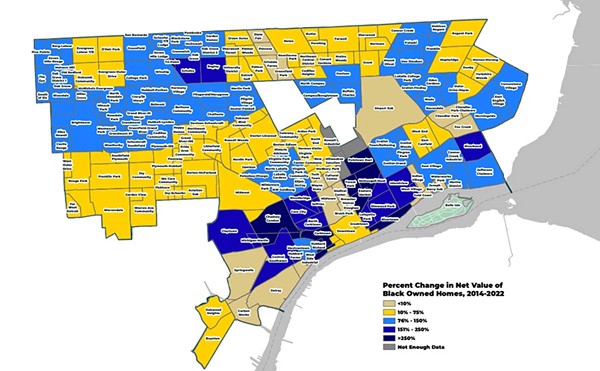Seventy-five summers ago, Detroit was home to a vibrant, thriving and industrious Mexican community. Life revolved around family, Our Lady of Guadalupe Catholic Church and days of hard labor in the auto plants.
Five years later, everything had changed. The church near Roosevelt and West Kirby, which was built by the Mexicans themselves, was in a steady decline as the southwest Detroit community comprising from 15,000 to 30,000 people of Mexican descent reeled from a devastating blow.
The reason for the demise of the Mexican community in Detroit and in cities across the nation was a little-reported, guileful, organized government campaign. The effort deprived thousands of Mexicans — most of whom were in the United States legally, many of whom were actually American citizens — of their basic civil liberties. They were sent packing back to Mexico as the United States confronted the economic horrors of the Great Depression.
It was called the Repatriation. Those who were its victims became collectively known as los repatriados.
History
Mexicans had been coming to Michigan in numbers since at least the 1880s, mainly to work in the sugar beet fields, most notably those of the Michigan Sugar Co., which had plantations and processing plants in Clinton, Gratiot, Lapeer, Saginaw and Tuscola counties. But by 1920, the lingering end of the decade-long Mexican Revolution and the labor shortage in Detroit-area auto plants combined to turn the trickle into a flood.
Jorge Chinea is nearing 50 and just starting to gray. Late last year he was appointed an associate professor of history and the director of the Center for Chicano-Boricua Studies at Wayne State University. He is renovating a house in Clinton Township where he lives with his family — his wife, his two sons, a daughter and a small Pomeranian named Paquito, who he laughingly refers to as his “fourth child.”
The house has a huge back lawn. A vegetable garden boasts a healthy assortment of tomatoes, peppers and squash. A tree-lined undeveloped lot next door gives him isolation. In measured distances it is hundreds of miles from the environment of his youth. In cultural and aesthetic distances, it is light years away.
Chinea grew up in a barrio near San Juan, Puerto Rico, moved to a Hispanic slum in New York City at 13 and fought his way into American academia through a gantlet of crime, youth gangs and drugs. His suburban home is now his sanctuary, with his bright, energetic family surrounding him. Even Paquito is friendly to the point of distraction.
Chinea says the rush of Mexicans to Detroit was well-orchestrated.
“A lot of them were recruited by local companies,” he says. “Ford Motor Company sent people to the border. They posted signs in the communities telling people that you could make so much money, that you could have housing, that you could eat three meals a day, that this was the way to go.
“You had a lot of deprivation in Mexico, a lot of instability; you had chaos. There were women who left simply because their husbands had died in the war and they had no means of supporting their families. So the enticement of a job in Michigan sounded great on paper. Companies used contractors known as coyotes. They would round up people and transport them illegally to the jobs in Michigan.”
And so they came, streams of Mexicans. For reasons that will be explained, it is not possible to know or even estimate closely the numbers. But they rushed to the opportunity, not only to the auto plants of Detroit, but to the cotton fields of the South and Southwest, to the farms of the Midwest, to the meat packing houses of Chicago and to wherever there was a railroad line waiting to be laid.
They had no idea what would befall them.
When the Depression hit in October of 1929, critics predicted the end of capitalism. Job opportunities ranged from scarce to nonexistent. A nationalistic swell of anti-Mexican sentiment grew into hysteria. Both those on the right and in organized labor, led by the American Federation of Labor, called for the preservation of jobs for “real Americans.”
The Herbert Hoover administration reacted by having the Immigration and Naturalization Service launch a campaign to deport the Mexicans, sending them back to their ravaged homeland, often without choice. So began the Repatriation.
As California State University professors Francisco E. Balderrama and Raymond Rodriguez reported in their book, Decade of Betrayal (1995, University of New Mexico Press), “As the deportation system was then structured … deportation proceedings were made to order for wholesale violations of basic human rights. Mass raids and arrests were conducted without the benefit of warrants. Individuals were often held incommunicado … Deportees languished in jail until the next deportation train was formed.”
Distinctions between legal and illegal, citizen and non-citizen, Mexican and Mexican-American were blurred.
“Los repatriados is a name that means the repatriated, but in a way it is a misnomer because the people who were victimized by this campaign to remove Mexicans from the United States in the 1930s were not always simply asked to leave,” Chinea says. “A lot of them were just deported. There were people who were born in America [and therefore U.S. citizens] who were never given the choice as to whether they wanted to leave or not.”
It was a time of terror for all Hispanics, according to Decade of Betrayal: “All Mexicans, whether legal or illegal, looked alike to immigration officials. In street sweeps throughout the nation’s major cities, people who ‘looked Mexican’ found themselves at risk of being picked up and taken into custody. To act first and ask questions later seemed to be the policy of the Immigration Service. Arrests were often made without warrants or even probable cause.”
Immigration laws did exist, as did a deportation-appeal process, but the language barrier often skewed the proceedings in favor of the government. And since immigration authorities served as prosecutors, judges and juries, appeals rarely went anywhere. The niceties of due process were often set aside. As detailed in Decade of Betrayal, appeals were largely moot.
“In reality, it was not difficult to convince Nationals that returning home voluntarily was the best choice available to them. The reason was quite simple: If individuals asked for a formal hearing and were denied entry, they were automatically barred from ever being eligible to reenter the United States. On the other hand, if they agreed to voluntary deportation, no arrest warrant was issued and no legal record or judicial transcript of the incident was kept. The deportees were free to reenter the U.S. legally at some future date.”
By all accounts, there were some Mexicans who wanted to go back. But Chinea says that it makes little sense that very many would have returned absent the INS’ deception and pressure.
“People were afraid of being deported and so they felt pressured,” he says. “Under those conditions, people were basically deceived into thinking that the government of Mexico and the government of the United States had concocted this master plan to help them. Mexico was in a recession after having gone through the Revolution from 1910 to 1920, the last thing you want to do is in the late 1920s is to go back to Mexico.”
The roughshod treatment of the Mexicans and the abuses of their rights by the INS did create a certain hue and cry among activists and civil libertarians. In response, the government created the Wickersham Commission, chaired by distinguished jurist Reuben Oppenheimer. In its 1932 report, the commission concluded: “The apprehension and examination of supposed aliens are often characterized by methods unconstitutional, tyrannic and oppressive.”
William N. Doak, Hoover’s labor secretary and point man in the repatriation campaign, denied all charges of abuse and misconduct. Nothing really changed.
People
The story of the Repatriation is more than a story of government abuse and a system that fostered the elimination of civil liberties. It is mostly a story about los repadriatos themselves, their families and how what happened 75 years ago wrenched a community in ways that still resound today.
Elena Herrada’s grandfather was one of los repadriados. A hyperactive woman of 47, Herrada grew up in an ethnic hodgepodge of an East Side Detroit neighborhood, moving to Sterling Heights as a teen. A self-described poor student in high school, she caught the education bug when a Latino studies professor cornered her on a visit with friends to Wayne State. She began a life of activism and is now the head of a small union local that represents cafeteria workers in Detroit-area auto plants. She has worked on many social justice issues in the Latino community. She is frustrated by the fact that although she can speak Spanish fluently, she can neither read nor write it.
“You know what they say about Chicanos,” she jokes. “We’re illiterate in two languages. That’s kind of the way it is because we didn’t have any way of learning.”
The Repatriation has become an obsession. Working with other activists, she has created a video on the subject, started a Web site — www.losrepatriados.org — and helped organize a weeklong conference on the subject that was held in Mexico in June. A mother of four daughters, her clean, well-kept house sits in the shadow of Tiger Stadium in southwest Detroit. In the back yard, a gurgling pond brings surprising touches of wildlife to the urban setting.
On a sparkling June day, Herrada sits on her front porch and talks about the Repatriation, Mexican-American culture and community in Detroit, and how they are connected.
“My grandfather came to Detroit in 1920 after the revolution,” she says. “A million people died in the revolution and probably another million came to the United States. There was nothing left there. It was devastated. Can you imagine traveling all that way, having nothing, not knowing how to read or write? Imagine how brave those people were.”
Herrada encountered a remarkable cultural phenomenon when her studies of the Repatriation led her to confront her grandfather.
“I took the book to my grandfather and I said, ‘This is what the scholars said happened. And I know you went to Mexico during the Depression. But is this what really happened?’ And my grandfather for a long time wouldn’t tell me that they had been forced to leave. And I still don’t know, because he died before I got the real story from him.”
It is this Mexican culture of silence, of forgetting, that has kept the story of the Repatriation from being widely disseminated.
Herrada speaks of a line from author John Philip Santos’ family memoir, Places Left Unfinished at the Time of Creation.
“He said, ‘Forgetting is to Mexicans what remembering is to Jews.’ That just resonates. Everyone knows about the Holocaust, many people know about the Japanese internments. In the Mexican community, those who returned did not talk about it. They did not tell their own families. In the beginning I couldn’t understand why people would not talk about it. And as I did more interviews and as I talked to more and more people and their descendants, it got to the point that I’m amazed that anyone talks about it at all. We’re very lucky to get their stories. It isn’t their fault. They didn’t understand it. They didn’t want to revisit it. They wanted to disappear it in their minds.”
In her attempt to recruit los repatriados for her conference in Mexico, Herrada ran up against the problem again. Only one would make the trip.
“They refused to go with us back to Mexico,” she says. “None of the people who got deported would go. Only one. The memories were way too bitter for them. They don’t know why we’re doing this or why we’re talking about it. They think we’re just revisiting wounds that are better left unopened.”
Chinea has also observed this phenomenon.
“The people that we interview said they have never told their children, because it would be demeaning for a father to have to admit he was thrown out,” he says. “In Latino culture, the men have to take care of their families. When you can’t do that, when you’re thrown out, it’s very demeaning. People wouldn’t talk about it.”
This cultural tendency toward silence extends not only to family, but to society and citizenship. According to Herrada, Mexicans have a tradition of keeping to themselves. This explains why no one knows how many Mexicans were living in Detroit in 1929. It explains why estimates of the number of Mexicans deported nationwide during the Repatriation vary from 300,000 to 1 million. No one knows. No one ever will know.
“We came from people who would not deal with the government at any level that they didn’t have to,” Herrada says. “This is why we don’t vote; this is why we don’t answer the census; this is why we don’t participate in anything government-related if we don’t have to. It’s just like a tradition that’s been passed down. We come from a tradition of non-participation. I joke that we don’t even RSVP. We never can know who’s coming to our events.”
One number we do know from the INS’s own reports is that from 1930 to 1939, Mexicans constituted 46.3 of all those deported from the United States. During that time, they comprised less than 1 percent of the population.
“Across the country 60 percent of those who were deported were U.S.-born,” Herrada says. “And nobody was illegal. There wasn’t a question of legality crossing the border then. People were invited to work here. They didn’t have to sneak across the border to get here.
“Wayne County was very involved in the Repatriation. They would just come to the houses and say, ‘You have to go.’ Mexicans were demonized by the press and by Congress and the general public. It was a horrendous thing to do. To target a community, to round them up, to tell them they had to leave.”
Racism was definitely in play. Chinea says social Darwinism, Manifest Destiny and the eugenics movement all fueled the deportation hysteria.
“We also had a nativistic movement in the United States that’s been there throughout our history where we always favor native-born over foreign-born. The labor movement was advancing the notion of nativism because they didn’t want foreign workers to be hired.”
Legacy
“For me, I was lonely for Mexicans growing up,” says Herrada, the pain still evident. “And when I did come around this Mexican community, I never wanted to leave it again. There’s great comfort in community. And that’s what the Mexicans lost.”
Much, if not most of the Mexican community eventually came back to Detroit. Again, there are no hard numbers, but the anecdotal evidence is strong. The Depression over, Detroit became the nation’s “Arsenal of Democracy” and the plants fired up again, this time making materiel and vehicles to fuel the World War II effort. Mexican labor was once more needed.
But great damage had been done. For the Mexicans, nothing would ever be the same.
“One of the effects of the Repatriation was that people came back and got extremely dissimilated,” Herrada says. “Many married non-Mexicans, moved away from the community, didn’t speak Spanish and didn’t have any connection with the community of Mexicans, which to me is the biggest loss. It’s like being banished. This was never articulated and when the people came back, they wouldn’t even tell their children why it wasn’t OK to be Mexican. So you had a whole generation of people who grew up being ashamed without knowing why. The fact that there is a Mexican community here is in itself an act of resistance. The need for association, for affiliation is greater than the fear. That’s how I feel.
“A lot of people think that Mexicans are backward because we’re less assimilated than other groups who started here around the same time. And we’re less educated and less successful financially. That’s a result of having been kicked back for a generation.”
Chinea agrees but says that there has not been enough research done to know the magnitude of the blow the Repatriation struck.
“Probably in that time frame, the Repatriation did a lot of damage to the Mexican communities,” he says. “It stunted them, just as they were growing. And so they had to restart again in the ’40s. This needs to be more quantified.”
For her part, Herrada has established Fronteras Nortenas, a nonprofit company that will seek grant money to keep open a Mexican museum in Detroit and to foster community education and oral history. Its goal, she says is “reclaiming our intellectual, historical and spiritual history.”
A lawsuit for compensation for los repatriados has been started in California. Chinea says speed is of the essence.
“There needs to be some kind of compensation,” he says. “I don’t know what form it would take. There needs to be some action taken now, because as time goes on, those records get shredded. The human record is also going away.”
Herrada says that the families by and large don’t want money “because money can’t replace what they’ve lost. Certainly the people who had this happen to them don’t want it to happen to anyone else. They understand what we’re doing. We’re not going for vengeance or even an apology. The great author Betita Martinez said, ‘I don’t want to participate in the oppression Olympics.’”
Government recognition of the atrocity would help, Herrada says. But what los repatriados really want, she says, is to make it unhappen. What she thinks about, she says, is why it happened. She grows quiet, diverting her eyes as she ponders the answer.
“I guess it happened because it could happen, for one thing,” she says. “The world was arranged in a different way then. It was kind of a mob behavior and mentality — retaining the jobs for ‘real Americans.’ And there were all these immigrants who weren’t ‘real Americans,’ who didn’t speak English, who looked different. They weren’t worthy of being here in difficult times. And they had no way to support themselves.
“I’ve been looking for this: Who stood up against this? And I haven’t found out yet.
“Nobody stopped it,” she whispers. “Nobody stopped it.”
Read more:
'A painful period'
Two who never came back
'Forget about civil rights'
Deportee documentary
Tom Schram is co-chair of the National Writers Union of Southeast Michigan. Send comments to [email protected]





